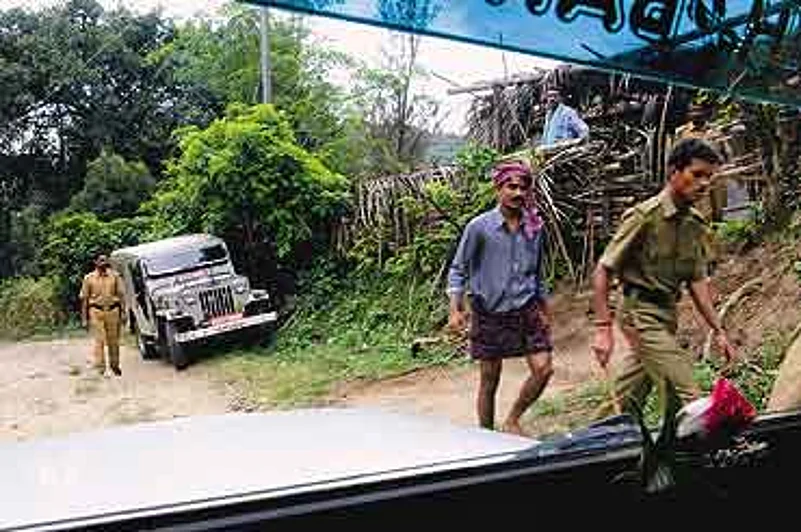
Forest officials, on condition of anonymity, tell a tale of gross neglect. "There is just one ranger, seven guards, five foresters and seven watchers for 250 sq km of forest where ganja is cultivated. We walk for a whole day into the forest, stay overnight, conduct the raids and walk back. The terrain is so bad there are areas where even while we are on top of a hill we can't see what goes on in the fields below. Whereas the cultivators would be watching us from a distance."
Apart from the terrain, the department that's meant to protect the forests is so ill-equipped that an honest officer has to borrow money from friends to buy diesel for his jeep. In two of the forest range offices, no outgoing calls can be made from office telephones. The local forest offices are yet to receive the allowances due to them for the last few raids. Hence the money required to arrange a raid—starting with provisions for a two-three day trek—has to come from the range officer's pocket.
So it came as no surprise when a recent vigilance case was registered against a range officer, caught with 40 kg of unaccounted dried ganja ready for sale. Locals, including politicians, believe it was kept in the range office for sale. According to one version (vehemently denied by the department), a bidder tipped off the vigilance department when he was denied the stock, which was being sold for a higher quoted price. When forest officials can't even make local calls or buy diesel, such incidents are only to be expected. As for the still-not-disillusioned youngsters who do organise the raids, they find there is no way to take the matter further, to trace the links of the ganja farmers to their patrons.
Migrants from Idukki, with a long history of ganja cultivation, have in the last decade turned Attappady into a haven for hemp growers. In turn, the trade has also affected the way the local tribals live and die. Tribes like Irula, Muduga and Kurumba (particularly the last one) have always grown ganja for their own consumption. The ancient barter system still exists in some Kurumba villages, where having lost the old ways of shifting cultivation some tribals resort to exchanging ganja for rice. Over the years, settlers from Tamil Nadu too have become traders of ganja, sold in Coimbatore just 48 km away.
Tribal ganja cultivators like Rangan, a matriculate, complain that all the raids are on tribal land and the foresters never venture into the "real farms". Even for Rangan, it makes sense to "show the right spot to the migrants" and pocket Rs 500, rather than wait for six months for acrop. "The most I have got is Rs 3,600 for 6 kgs," he says.
The Idukki-bred Malayalee marijuana growers meanwhile take the tribals' help in seeking out inaccessible forest tracts, invisible to the foresters who stick to the mountainpaths. In the midst of dense forests, they burn down huge trees to prepare theground. It is here that the best Kerala strain, the 'neela chadayan' or the blue plant, is cultivated. Forest officials have taken photographs of ganja nurseries deep inside the forests, where the seeds are fertilised in polythene bags.
Tony Thomas of the ngo One Earth One Life who has accompanied over 10 raiding parties deep into the forests, says there could be at least 700 acres under organised ganja cultivation by the migrants. The commercial value of this crop—over Rs 700 crore. He insists that most of the high value weed is processed into ganja oil, which makes transportation easy. This theory is supported by Narcotics Control Bureau (NCB) officials, who believe that most of the high-end ganja cultivated in the Attappady hills are exported by sea in the form of oil.
P. Raghu, a tribal school dropout from Dundoor in the ganja-growing part of Attappady, has a similar take. Till four years ago, he used to be a farm hand for migrant ganja cultivators. "I used to get Rs 60 a day and food. Their farms are incomparable with those of the tribes. Our people just grow a few plants without fertilisers or pesticides.... The migrants do it scientifically. Our yield is low too, fetching at the most Rs 1,500 per kg. Their plots would have at least 1,000 plants in an acre, and each plant yields at least a kilo of ganja. And a kilo means Rs 7,000-8,000," says Raghu.
In fact, many locals believe it is the weed grown by the tribals that is traded in Attappady and consumed in the neighbouring towns and cities. The superior variety is spirited away. Ironically, with every shipment of ganja oil sold in the international market, Attappady seems to become more and more impoverished. Its population has been reduced to becoming bonded labour, couriers, pimps and prostitutes. Meanwhile, yet another patch in one of the richest forest reserves of the state is being cleared to make way for another plantation. All this while the government and the police close their eyes and feign ignorance.






















